ผู้ใช้:Mattis/History 1

|
กะบะทราย : Sutton Hoo; วิลักษณ์; Valencia {{สั้นมาก}} {{ความหมายอื่น|เกี่ยวกับ= |สำหรับ= |ดูที่=bbb |เปลี่ยนทาง=}} {{ระวังสับสน|bbb}} {{บทความหลัก|xxx}} {{ชื่ออื่น|หัวข้อ|หัวข้ออื่น|บทความ}} {{ใช้ปีคศ|width=290px}} ({{lang-en|aaa}}) {{รายการอ้างอิง}} ในปี ค.ศ. ในปี [[ค.ศ. ]] “XX” “[[XX|XX]]” “''[[XX|XX]]''” |]] () <br>{{spaces|4}} <ref>[]</ref> | etitle=<small>XX</small> Add Thai interwiki '''([http://www.forvo.com/word/aaa#en ออกเสียง])''' [[:Image:aaa.jpg|“aaa”]] “''[[oo|oo]]''”({{lang-th|“''oo''”}}) <!--xx--> |
Medieval art
ที่มา[แก้]

ในร้อยปีแรกของยุคกลางเป็นสมัยของความเสื่อมโทรมทางเศรษฐกิจ, ทางด้านความมั่นคง และ ทางด้านประชากร มาจนกระทั่งถึงปี ค.ศ. 800 หลังจากนั้นสถานภาพก็ค่อยคงตัวมาเป็นลำดับโดยมีการขยายตัวขึ้นจนกระทั่งเมื่อมาประสบวิกฤติการณ์ครั้งใหญ่ของกาฬโรคระบาดในยุโรปเมื่อราว ค.ศ. 1350 ที่คร่าชีวิตประชากรของยุโรปไปราวหนึ่งในสามของประชากรทั้งหมด โดยจำนวนการสูญเสียทางตอนใต้จะสูงกว่าทางตอนเหนือ จำนวนประชากรของภูมิภาคบางภูมิภาคก็มิได้ฟื้นตัวกลับมาเท่ากับสมัยก่อนหน้าการสูญเสียจนกระทั่งเมื่อมาถึงคริสต์ศตวรรษที่ 17 ประชากรในยุคกลางของยุโรปประมาณกันว่าลดลงต่ำสุดถึง 18 ล้านคนในปี ค.ศ. 650, มาขึ้นเป็นเท่าตัวในปี ค.ศ. 1000, และเพิ่มจำนวนขึ้นถึง 70 ล้านคนในปี ค.ศ. 1340 ที่เป็นจำนวนก่อนที่จะเกิดโรคระบาด ในปี ค.ศ. 1450 ยุโรปก็ยังคงมีประชากรเพียง 50 ล้านคน ตัวเลขเหล่านี้ ยุโรปเหนือโดยเฉพาะบริเตนเป็นอัตราที่ต่ำกว่าในปัจจุบัน และมาเป็นอัตราที่สูงกว่าทางตอนใต้ของยุโรปรวมทั้งฝรั่งเศส[1] ผู้ที่มีฐานะมั่งคั่งก็ได้รับผลกระทบกระเทือนน้อยกว่าจากโรคระบาด ผลของการสูญเสียประชากรเป็นจำนวนมหาศาลจากโรคระบาดทำให้ยุโรปมีปัญหาขาดแรงงานทางเกษตรกรรมที่ดำเนินมาจนถึงคริสต์ศตวรรษที่ 11 ที่ดินเป็นอันมากก็ถูกทิ้งว่างเปล่า แต่ปรากฏการณ์โลกร้อนในยุคกลางก็ทำให้ยุโรปได้รับผลประโยชน์ทางด้านการเกษตรกรรมมาจนถึง ค.ศ. 1315


ในที่สุดยุคกลางก็ประสบการสลายตัวของการรุกรานจากภายนอกที่เกิดขึ้นในช่วงร้อยปีแรก การพิชิตดินแดนโดยมุสลิมในคริสต์ศตวรรษที่ 6 และ 7 แยกแอฟริกาเหนือจากยุโรปอย่างเป็นการถาวรอย่างรวดเร็ว และในที่สุดชาวมุสลิมก็มีอิทธิพลเหนือจักรวรรดิไบแซนไทน์มาจนกระทั่งการสิ้นสุดของยุคกลางของยุโรปที่เป็นคาทอลิก แต่ยุโรปได้คาบสมุทรไอบีเรียทางตะวันตกเฉียงใต้ของยุโรปคืน
เมื่อยุคกลางเริ่มขึ้นงานศิลปะที่สำคัญเป็นสิ่งที่หายากและมีราคาสูง ผู้เป็นเจ้าของได้ก็จะต้องเป็นผู้ที่มีฐานะดีเท่านั้นเช่นชนชั้นสูง, สำนักสงฆ์, หรือคริสต์ศาสนสถานขนาดใหญ่ และถ้าเป็นงานทางศาสนาก็มักจะสร้างโดยนักบวช เมื่อมาถึงปลายยุคกลางก็เริ่มเห็นงานศิลปะที่ค่อนข้างมีฝีมือเพิ่มขึ้นในระดับหมู่บ้านขนาดย่อม และ ในบ้านของผู้มีอันจะกินชั้นกลางในเมือง นอกจากนั้นการผลิตงานศิลปะในหลายท้องที่ก็กลายเป็นอุตสาหกรรมสำคัญของท้องถิ่น จนศิลปินที่เป็นนักบวชเป็นสิ่งที่หาได้ยาก
ทัศนคติที่อาจจะยังคงเชื่อกันอยู่ว่าศิลปะยุคกลางเป็นศิลปะที่เกี่ยวข้องกับคริสต์ศาสนาเท่านั้น ซึ่งไม่ตรงต่อความจริง แม้ว่าคริสต์ศาสนสถานจะกลายมามีฐานะมั่งคั่งในช่วงยุคกลาง และบางครั้งก็ยอมใช้ทุนอย่างฟุ่มเฟือยในการสร้างงานศิลปะ แต่งานศิลปะที่สร้างกันในยุคนี้ก็ไม่จำกัดแต่เพียงศิลปะที่เกี่ยวข้องกับคริสต์ศาสนาเท่านั้น แต่รวมไปถึงศิลปะทางโลกที่มีคุณค่าประมาณกัน แต่เป็นอัตราของความบอบช้ำ, เสียหาย หรือถูกทำลายจะสูงกว่า ทัศนคติของยุคกลางไม่เน้นการอนุรักษ์งานศิลปะโบราณอันมีคุณค่าทางศิลปะ ไม่เหมือนกับการอนุรักษ์มงคลวัตถุของนักบุญ และในยุคฟื้นฟูศิลปวิทยาและบาโรกต่อมาก็จะดูแคลนศิลปะยุคกลาง
หนังสือวิจิตรอันหรูหราของยุคกลางตอนต้นจะหุ้มหน้าปกด้วยโลหะมีค่า, งาช้าง และอัญมณี ชิ้นส่วนของหน้าปกยังคงหลงเหลืออยู่เป็นจำนวนมากกว่าที่เป็นหน้าปกที่สมบูรณ์ จากการที่ถูกเลาะเอาของมีค่าบนหน้าปกออกในอดีต
ในช่วงนี้คริสต์ศาสนสถานส่วนใหญ่ได้รับการสร้างขึ้นใหม่ แทนที่สิ่งก่อสร้างที่เสื่อมโทรมลงไป ในอังกฤษคริสต์ศาสนสถานที่สร้างตั้งแต่คริสต์ศตวรรษที่ 7 เป็นต้นมาคงตั้งอยู่โดยไม่มีการเปลี่ยนแปลงเป็นอันมา และยิ่งเป็นจำนวนมากกว่าเมื่อกล่าวถึงสถาปัตยกรรมที่สร้างในคริสต์ศตวรรษถัดมา ตัวอย่างเช่นเพียงแต่เมืองนอริชเท่านั้นก็มีคริสต์ศาสนสถานของยุคกลางถึง 40 หลัง แต่สิ่งก่อสร้างที่เป็นพระราชวังไม่มีสิ่งใดที่ยังคงตั้งอยู่ให้เห็นที่สร้างก่อนคริสต์ศตวรรษที่ 11 ถึงกระนั้นก็ยังมีเหลืออยู่เพียงไม่กี่แห่ง ส่วนใหญ่แล้วจะยังคงเหลือแต่ซาก[2] สถานการณ์คล้ายคลึงกันก็เกิดขึ้นในยุโรป แต่ก็มีสิ่งก่อสร้างเช่นพระราชวังพระสันตะปาปาแห่งอาวินยองที่สร้างในคริสต์ศตวรรษที่ 14 ที่ยังตั้งอยู่โดยแทบจะไม่มีการเปลี่ยนแปลง ข้อโต้แย้งที่เกี่ยวกับอายุและที่มาของสิ่งก่อสร้างของคฤหัสน์แต่ละแห่งดำเนินต่อเนื่องกันเป็นเวลานาน เพราะแทบจะไม่มีหลักฐานเหลืออยู่ให้ศึกษา เช่นในกรณีพิพิธภัณฑ์บริติชไม่ยอมรับเข็มกลัดฟุลเลอร์ที่อ้างว่าเป็นงานของสมัยแองโกล-แซ็กซอนเป็นของแท้ และกล่าวว่าเป็นงานปลอม[3]
การใช้วัสดุมีค่าเป็นลักษณะหนึ่งที่นิยมกันในการสร้างศิลปะยุคกลาง มากยิ่งไปกว่าเงินที่ว่าจ้างศิลปิน แม้ว่าเป็นศิลปินที่ไม่ใช่นักบวชก็ตาม วัสดุที่ใช้ก็รวมทั้งทองอันเป็นโลหะมีค่าที่ใช้สำหรับพระราชวังหรือคริสต์ศาสนสถาน, เครื่องประดับที่ทำด้วยอัญมณี และ เครื่องประดับเครื่องแต่งกายและชิ้นทองที่ประดับเป็นฉากหลังในงานโมเสก หรือการใช้ทองคำเปลวในการเขียนภาพประดับหนังสือวิจิตรและจิตรกรรมแผง
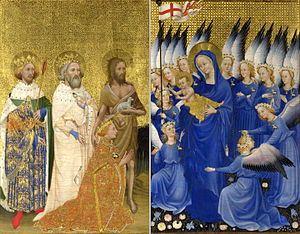
วัสดุที่มีราคาสูงยิ่งขึ้นไปอีกอย่างหนึ่งคือหินลาพิส ลาซูไลจากอัฟกานิสถานที่ใช้ทำสีสีน้ำเงินทะเล มาใช้กันมากในสมัยกอธิค ที่ใช้ในการวาดเสื้อคลุมของพระแม่มารีมากกว่าที่ใช้กันในการวาดท้องฟ้า หรืองาช้างที่มักจะระบายสีก็เป็นวัสดุสำคัญอีกอย่างหนึ่งจนกระทั่งเกือบตอนปลายสุดของสมัยสมัย การใช้วัสดุที่มีราคาสูงและมีค่าแสดงให้เห็นถึงการวิวัฒนาการของศิลปะที่เริ่มขึ้นด้วยบานพับกงสุลไปเป็นสิ่งที่ทำเพื่อศาสนาเช่นหน้าปกหนังสือ, หีบวัตถุมงคล และ คทานักบวช แต่เมื่อมาถึงสมัยกอธิคตลับกระจก, โลงศพ และ หวีวิจิตรก็กลายมาเป็นสิ่งที่พบกันโดยทั่วไปในบรรดาผู้มีฐานะดี การที่งานแกะสลักงาช้างยังคงมีเหลืออยู่ให้เห็นอาจจะเป็นเพราะเป็นงานที่นำกลับมาใช้เป็นประโยชน์อย่างอื่นได้ยาก เช่นเดียวกับหน้าหนังสือ
แม้ว่าวัสดุเหล่านี้จะมีราคาสูงและหายากก็ตามแต่ก็ยังยอมสร้างกัน เมื่อแอบบีมองค์เวียร์มัธ-จาร์โรว์ของแองโกล-แซ็กซอนวางแผนที่จะสร้างงานก็อปปีพระคัมภีร์ไบเบิลในปี ค.ศ. 692 — ที่ฉบับหนึ่ง “พระวรสารอมิอานินัส” ยังคงอยู่ — ก้าวแรกในการเตรียมตัวคือการต้องผสมพันธุ์วัวเอาไว้ให้ผลิตลูกวัวเป็นจำนวน 1,600 ตัวเพื่อให้พอเพียงกับนำเอาหนังมาทำเป็นกระดาษหนังตามต้องการ[4]
กระดาษเริ่มมีใช้กันในศตวรรษสุดท้ายของสมัยแต่ก็ยังมีราคาสูงมากเมื่อเปรียบเทียบกับปัจจุบัน ภาพพิมพ์แกะไม้ที่เป็นจุลหนังสือที่มีขนาดเล็กเท่ากล่องไม้ขีดหรือเล็กกว่านั้น ก็มีการสร้างกันขึ้นสำหรับขายให้แก่นักแสวงบุญตามสักการะสถาน จากกาลานุกรมต้นไม้พบว่าไม้โอ้คส่วนใหญ่ที่ใช้ในการเขียนจิตรกรรมแผงในสมัยจิตรกรรมยุคเนเธอร์แลนด์ตอนต้นของคริสต์ศตวรรษที่ 15 ไปตัดมาจากบริเวณลุ่มแม่น้ำวิสตูลาในโปแลนด์ โดยการล่องลงมาตามลำแม่น้ำและข้ามทะเลบอลติก และ ทะเลเหนือไปยังเมืองท่าที่ฟลานเดอร์ ก่อนที่จะทิ้งไว้เป็นเวลาอีกหลายปีให้อยู่ตัว[5]
หัวเรื่องงานศิลปะของยุคกลางมีเนื้อหาที่กว้างขวาง และนักประวัติศาสตร์ศิลป์แบ่งออกเป็นลักษณะ และช่วงเวลา แต่การเริ่มและการสิ้นสุดก็ไม่ชัดเจนเสมอไป หรือในเวลาเดียวกันในภูมิภาคต่างๆ หรือแม้แต่ในกรณีของช่วงเวลาภายของสมัยศิลปะเดียวกัน[6]
คริสเตียนตอนต้นและปลายยุคโบราณ[แก้]

ศิลปะคริสเตียนยุคแรกที่โดยทั่วไปหมายถึงศิลปะตั้งแต่ยุคโบราณตอนปลายในช่วงระยะเวลาราวปี ค.ศ. 200 จนกระทั่งเมื่อมาถึงช่วงที่งานศิลปะวิวัฒนาการไปเป็นแบบไบแซนไทน์เต็มตัวเมื่อราวปี ค.ศ. 500 แต่ช่วงเวลาเริ่มต้นที่เริ่มขึ้นเมื่อใดทั้งในบริบทของประวัติศาสตร์โดยทั่วไปและประวัติศาสตร์ศิลปะก็ยังคงเป็นเรื่องที่ถกเถียงกันอยู่ แต่โดยทั่วไปก็จะอยู่ในช่วงเวลาดังกล่าว ในช่วงคริสต์ศตวรรษที่ 4 คริสต์ศาสนาเปลี่ยนจากศาสนานอกกฎหมายที่ผู้นับถือถูกไล่ทำร้ายและสังหารมาเป็นศาสนาทางการของจักรวรรดิโรมันอันศักดิ์สิทธิ์ ที่ผสานลักษณะงานของศิลปะและสามัญสัญลักษณ์โรมันของทั้งศิลปะสมัยนิยมและศิลปะในราชสำนัก ตั้งแต่เริ่มต้นงานศิลปะคริสเตียนที่ยังคงหลงเหลือให้เห็นอยู่เป็นงานเขียนภาพบนผนังที่เก็บศพที่นิยมทำกันในสุสานใต้ดินแห่งกรุงโรม แต่เมื่อมาถึงปลายสมัยงานก็วิวัฒนาการมาเป็นการตกแต่งด้วยงานโมเสกอย่างหรูหราภายในคริสต์ศาสนสถานที่สร้างโดยพระบรมราชูปถัมภ์ของพระจักรพรรดิ ในช่วงระยะเวลานี้ราชศิลปะโรมันโบราณตอนปลายกลายไปเป็นศิลปะที่มีลักษณะใกล้เคียงกับศิลปะบาโรก หันจากความเป็นสัจนิยมของศิลปะคลาสสิกไปหาศิลปะแบบลึกลับมีมนต์ขลังแทนที่ — กระบวนการวิวัฒนาการที่เกิดขึ้นนานก่อนที่คริสต์ศาสนาจะกลายมาเป็นศิลปะที่มีอิทธิพลต่อศิลปะในราชสำนัก กระบวนของการเปลี่ยนแปลงนี้ได้รับอิทธิพลจากทางตะวันออกของจักรวรรดิ—อียิปต์, ซีเรีย และไกลออกไป และ แบบพื้นเมืองของอิตาลี รูปลักษณ์ที่สร้างส่วนใหญ่ยังคงเป็นรูปที่มองจากด้านหน้าที่มองตรงมายังผู้ชม ซึ่งต่างจากศิลปะคลาสสิกที่มักจะเน้นด้านข้าง - การเปลี่ยนแปลงดังกล่าวปรากฏแม้แต่บนเหรียญกษาปณ์
เมื่อมาถึงสมัยนี้จุดเด่นของลักษณะอันเป็นเอกลักษณ์ของตัวแบบในการเขียนภาพเหมือนของศิลปะโรมันเสื่อมโทรมลงอย่างรวดเร็ว และสรีระและรอบพับและรอยพริ้วของผ้าก็ขาดความเป็นจริง ตัวแบบของยุคกลางของยุโรปเหนือในการเลียนแบบศิลปะโรมันสร้างตามแบบงานที่โยกย้ายได้ของสมัยโบราณตอนปลาย และ งานสลักโลงหินที่พบโดยทั่วไปในจักรวรรดิโรมัน[7]
งานแกะงาช้าง
-
“อัสสัมชัญของพระเยซู” และ “อย่ายึดข้า” ราว ค.ศ. 400 ที่ยังคงมีลักษณะคลาสสิกหลงเหลืออยู่บ้าง ดู “หนังสือประกอบพิธีโดรโก” สำหรับ “อัสสัมชัญของพระเยซู” 450 ปีต่อมา
-
บานพับกงสุล, คอนสแตนติโนเปิล ค.ศ. 506 แบบสมัยโบราณตอนปลายเต็มตัว
-
งานแกะนูนออตโตเนียนจากแท่นบูชาที่พยายามเลียนแบบศิลปะคลาสสิก, มิลาน ค.ศ. 962–973
-
บานพับภาพแบบกอธิคฝรั่งเศส, ปลายคริสต์ศตวรรษที่ 14 อาจจเป็นของคฤหัสน์ ที่เป็นฉากจาก “ชีวิตของพระแม่มารี”
ศิลปะไบแซนไทน์[แก้]
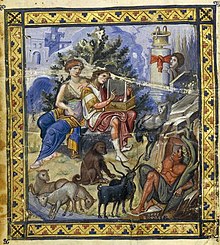
ศิลปะไบแซนไทน์เป็นศิลปะของจักรวรรดิไบแซนไทน์ที่พูดภาษากรีก ที่ก่อตั้งขึ้นจากการแบ่งจักรวรรดิโรมันเป็นสองอาณาจักร--จักรวรรดิโรมันตะวันออกและจักรวรรดิโรมันตะวันตก--ที่บางครั้งก็รวมบางส่วนของอิตาลีภายใต้การปกครองของไบแซนไทน์ ศิลปะของยุคนี้วิวัฒนาการมาจากสมัยโบราณตอนปลายราวประมาณ ค.ศ. 500 ระหว่างการทำลายรูปเคารพสมัยไบแซนไทน์ระหว่างปี ค.ศ. 730 ถึงปี ค.ศ. 843 รูปสัญลักษณ์ทางศาสนาส่วนใหญ่ถูกทำลายไปเป็นอันมาก ฉะนั้นจึงแทบจะไม่เหลือสิ่งใดไว้เป็นหลักฐาน นอกไปจากงานที่พบในอิตาลี (โรม และ ราเวนนา และอื่นๆ) หรือที่สำนักสงฆ์แคทเธอรีน, เมานท์ไซนายในอียิปต์
ศิลปะไบแซนไทน์เป็นศิลปะแบบอนุรักษนิยม ที่ดำเนินการรักษาประเพณีนิยมของการสร้างงานแบบสัจนิยมแบบกรีกที่เน้นความเป็นปฏิปักษ์ต่อความเหมือนจริง หลังจากการกลับมาสร้างรูปสัญลักษณ์กันอีกครั้งใน ค.ศ. 843 จนกระทั่ง ค.ศ. 1453 ลักษณะของการสร้างศิลปะไบแซนไทน์ก็ดำเนินต่อมาตามแบบแผนเดิมโดยแทบจะไม่มีการเปลี่ยนแปลงที่อาจจะเป็นเพราะความเชื่องช้าของความเสื่อมโทรมของจักรวรรดิ เช่นที่เห็นได้ในงานฟื้นฟูศิลปะคลาสสิกในงาน “หนังสือเพลงสวดสดุดีปารีส” ของราชสำนักในคริสต์ศตวรรษที่ 10 และตลอดสมัยนี้งานเขียนหนังสือวิจิตรก็รักษารูปทรงแบบเดียวกันนี้ ที่ใช้โดยศิลปินคนเดียวกัน โดยตัวแบบรูปลักษณ์จะอยู่ในกรอบ และ ฉากที่ไม่ค่อยเป็นทางการจะวาดโดยไม่มีกรอบบนขอบหนังสือที่มีลักษณะที่เป็นสัจนิยมสูงกว่า[8] มหาประติมากรรมเป็นงานต้องห้ามแทบจะไม่มีข้อยกเว้นในสมัยศิลปะไบแซนไทน์ แต่งานแกะสลักงาช้างขนาดเล็กที่ส่วนใหญ่เป็นรูปสัญลักษณ์ (บานพับภาพฮาร์บาวิลล์ที่สร้างในสมัยเดียวกับ “หนังสือเพลงสวดสดุดีปารีส” แต่คนละลักษณะ) เป็นงานเด่นของยุคนี้ เช่นเดียวกับงานแกะนูนบนชาม และ สิ่งของที่ทำด้วยโลหะ
จักรวรรดิไบแซนไทน์สร้างงานที่มีชั้นดีที่สุดของยุคกลางในด้านคุณภาพของวัสดุที่ใช้ และ ฝีมือที่ทำโดยมีศูนย์กลางของการผลิตอยู่ที่คอนสแตนติโนเปิล แม้ว่านักประวัติศาสตร์บางคนจะมีความสงสัยต่อการสรุปโดยทั่วไปว่างานที่มีฝีมือดีๆ ที่ไม่ทราบที่สร้างก็น่าจะเป็นงานที่สร้างขึ้นในคอนสแตนติโนเปิล งานที่เด่นของศิลปะไบแซนไทน์คืองานจิตรกรรมฝาผนัง และ งานโมเสกภายในโดมของคริสต์ศาสนสถาน แต่ส่วนใหญ่ถูกทำลายไปแทบทั้งสิ้นเพราะภัยพิบัติทางธรรมชาติ หรือการเปลี่ยนคริสต์ศาสนสถานเป็นมัสยิด

ศิลปะไบแซนไทน์ค่อยคืบเข้ามามีอิทธิพลต่อศิลปะตะวันตก ราชสำนักและสำนักสงฆ์ไบแซนไทน์แม้ว่าจะมาในสมัยหลังของจักรวรรดิก็ยังเป็นแบบอย่างให้แก่ประมุขและนักบวชตะวันตก เช่นผ้าไหมไบแซนไทน์ที่มักจะทอหรือปักด้วยลวดลายของทั้งสัตว์และคน ลายรูปสัตว์มักจะมีอิทธิพลจากประเพณีนิยมที่ไกลออกไปทางตะวันออก ที่แทบจะไม่มีผลแต่อย่างใดในโลกของคริสเตียนมาจนกระทั่งสมัยสุดท้ายของจักรวรรดิ งานเหล่านี้ส่วนใหญ่สร้างขึ้นในราชสำนักในคอนสแตนติโนเปิล งานตกแต่งอื่นๆ แทบจะไม่มีการวิวัฒนาการ คุณภาพของงานเครื่องปั้นดินเผาไบแซนไทน์แทบจะไม่เกินไปกว่าศิลปะพื้นบ้าน.
ศิลปะค็อพติคของอียิปต์มีแนวการเปลี่ยนแปลงที่ต่างออกไป หลังจากนิกายค็อพติคแยกตัวออกไปเมื่อกลางคริสต์ศตวรรษที่ 5 ก็ไม่รับการสนับสนุนโดยรัฐ และอิทธิพลจากงานอียิปต์ท้องถิ่นก็กลายมามีอิทธิพลต่อศิลปะยุคกลาง ที่เป็นงานที่ขาดลักษณะของความเป็นจริง และ บางครั้งก็มีลักษณะที่เรียกว่าเป็น บรรพศิลป์ ที่เป็นภาพตัวแบบที่มีดวงตาโตลอยตัวอยู่กลางพื้นภาพ การตกแต่งใช้ลวดลายเรขาคณิต ที่คล้ายคลึงกับงานของอิสลาม เพราะสภาวะการอนุรักษ์ของที่บรรจุศพของอียิปต์ ทำให้เรามีความรู้เกี่ยวกับเสื้อผ้าที่ใช้โดยชนสามัญชาวอียิปต์มากกว่าที่ใด การตกแต่งมักจะเป็นการตกแต่งอย่างหรูหราเป็นรูปคนและลวดลาย ธรรมเนียมนิยมอื่นๆ ในอาร์เมเนีย, ซีเรีย, จอร์เจีย และอื่นๆ แสดงการตกแต่งที่จะไม่หรูหราเท่าแต่จะมีพลังมากกว่าศิลปะที่สร้างในคอนสแตนติโนเปิล โดยเฉพาะการสร้างงานสถาปัตยกรรมที่อาจจะมีอิทธิพลต่อยุโรปตะวันตก
ศิลปะสมัยการโยกย้ายถิ่นฐาน[แก้]
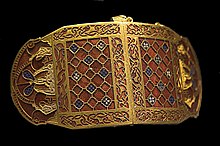
ศิลปะสมัยการโยกย้ายถิ่นฐาน describes the art of the "อนารยชน" Germanic and Eastern-European peoples on the move during the Migration Period from about 300-900; the blanket term covers early ศิลปะแองโกล-แซ็กซอน, ศิลปะวิซิกอธ, ศิลปะนอร์ส, ศิลปะเมโรแว็งเชียง, all of which made use of the animal style, which by this period had reached a much more abstracted form than in earlier Scythian art or that of the La Tène culture. Most artworks were small and portable, those surviving mostly jewellery and งานโลหะ, with the art expressed in geometric or schematic designs, often beautifully conceived and made, with few human figures and no attempt at realism—the early Anglo-Saxon grave goods from ซัททันฮู are among the best examples. As the "barbarian" peoples were Christianized, these influences interacted with the post-classical Mediterranean Christian artistic tradition, and new forms like the หนังสือวิจิตร,[10] and indeed coins, which attempted to emulate Roman provincial coins and Byzantine types. Early coinage like the sceat shows designers completely unused to depicting a head in profile grappling with the problem in a variety of different ways. There are references to wooden pagan statues, all now lost, and in Norse art the tradition of carved runestones was maintained after their conversion to Christianity. The Picts of Scotland also carved stones before and after conversion, and the distinctive Anglo-Saxon and Irish tradition of large outdoor carved crosses may reflect earlier pagan works.
-
Parts of a Norwegian wooden doorway, คริสต์ศตวรรษที่ 12, in the Urnes style
-
Image-stone from นอร์เวย์
ศิลปะเกาะ[แก้]
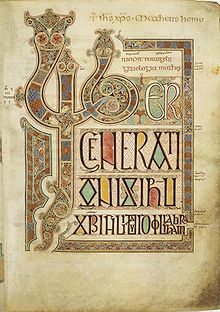
ศิลปะเกาะ refers to the distinct style found in ไอร์แลนด์ and Britain from about the คริสต์ศตวรรษที่ 7 century, to about the คริสต์ศตวรรษที่ 10, lasting later in ไอร์แลนด์. The style saw a fusion between the traditions of ศิลปะเคลติก, the Germanic ศิลปะสมัยการโยกย้ายถิ่นฐาน of the แองโกล-แซ็กซอน and the Christian forms of the book, high crosses and liturgical งานโลหะ. Extremely detailed geometric, ลายสอดประสาน, and stylised animal decoration, with forms derived from secular งานโลหะ like brooches, spread boldly across manuscripts, usually หนังสือพระวรสารs like the “พระวรสารเคลล์ส”, with whole carpet pages devoted to such designs, and the development of the large decorated and อักษรตัวต้นประดิษฐ์. There were very few human figures—most often these were ภาพเหมือนประกาศก—and these were crude, even when closely following ยุคโบราณตอนปลาย models.
The insular manuscript style was transmitted to the continent by the คณะเผยแพร่คริสต์ศาสนาไฮเบอร์โน-สกอตแลนด์ and its anti-classical energy was extremely important in the formation of later medieval styles. In most ยุคโบราณตอนปลาย manuscripts text and decoration were kept clearly apart, though some initials began to be enlarged and elaborated, but major insular manuscripts sometimes take a whole page for a single initial or the first few words (see illustration) at beginnings of gospels or other sections in a book. Allowing decoration a "right to roam" was to be very influential on ศิลปะโรมาเนสก์และกอธิค in all media.
การก่อสร้างสำนักสงฆ์ที่เป็นสถานที่ที่มีการสร้างหนังสือพระวรสารแบบศิลปะเกาะ The buildings of the monasteries for which the insular หนังสือพระวรสารs were made were then small and could fairly be called primitive, especially in ไอร์แลนด์. There increasingly were other decorations to churches, where possible in precious metals, and a handful of these survive, like the ถ้วยอาร์ดาห์, together with a larger number of impressive pieces of secular jewellery, probably worn mainly by men, and mainly brooches, of which the เข็มกลัดทารา is the most spectacular.
"Franco-Saxon" is a term for a school of late Carolingian illumination in north-eastern ฝรั่งเศส that used insular-style decoration, including super-large initials, sometimes in combination with figurative images typical of contemporary French styles. The "most tenacious of all the Carolingian styles", it continued until as late as the คริสต์ศตวรรษที่ 11.[11]
Giant initials
-
Carolingian version of Insular style—compare the "Liber generationis…" above.
-
Franco-Saxon "In principio", 871-3.
-
ลายสอดประสานแบบโรมาเนสก์, "inhabited" with figures, อังกฤษ, ค.ศ. 1190-1200.
-
Typical Gothic pen flourishes in an unillustrated working copy of John's gospel in English, late 14th century.
The influence of Islamic art[แก้]

Islamic art during the ยุคกลาง falls outside the scope of this article, but its influence needs mention. Islamic art covers a wide variety of media including calligraphy, illustrated manuscripts, textiles, ceramics, งานโลหะ and glass, and refers to the art of Muslim countries in the Near East, Islamic Spain, and Northern Africa, though by no means always Muslim artists or craftsmen—glass production, for example, remained a Jewish speciality throughout the period, and Christian art, as in [[|ศิลปะและสถาปัตยกรรมค็อพติค|Coptic Egypt]] continued, especially during the earlier centuries. There was an early formative stage from 600-900 and the development of regional styles from 900 onwards. Early Islamic art was not as opposed to compositions including human figures, though not of religious figures, as it later became, and used งานโมเสก artists and sculptors trained in the Byzantine and Coptic traditions.[12] อักษรวิจิตร, ornament and the decorative arts generally were more important than in the West; for most of the period Islamic countries were generally wealthier than Christian ones. The earliest dated painted tiles are from 862-3 at the Great Mosque of Kairouan in modern Tunisia, though the finest works in the medium did not come until much later.[13]
Islamic rulers controlled at various points parts of Southern Italy and most of modern สเปนและโปรตุเกส, as well as the คาบสมุทรบอลข่าน, all of which retained large Christian populations. The Christian Crusaders equally ruled Islamic populations. ศิลปะครูเสด is mainly a hybrid of Catholic and Byzantine styles, with little Islamic influence, but the Mozarabic art of Christians in อัล-อันดะลุส seems to show considerable influence from Islamic art, though the results are little like contemporary Islamic works. Islamic influence can also be traced in the mainstream of Western medieval art, for example in the Romanesque portal at Moissac in southern ฝรั่งเศส, where it shows in both decorative elements, like the scalloped edges to the doorway, the circular decorations on the lintel above, and also in having Christ in Majesty surrounded by musicians, which was to become a common feature of Western heavenly scenes, and probably derives from images of Islamic kings on their diwan.[14]
ศิลปะยุคก่อนโรมาเนสก์[แก้]

ศิลปะยุคก่อนโรมาเนสก์ is a term for architecture and to some extent pictorial and portable art found initially in Southern Europe (Spain, Italy and Southern ฝรั่งเศส) between the สมัยโบราณตอนปลาย to the start of the สมัยโรมาเนสก์ in the คริสต์ศตวรรษที่ 11. Northern European art gradually forms part of the movement after Christianization as it assimilates post-classical styles. ศิลปะคาโรแล็งเชียงของจักรวรรดิแฟรงค์, especially modern ฝรั่งเศส and เยอรมนี,, from roughly ค.ศ. 780-ค.ศ. 900 takes its name from จักรพรรดิชาร์เลอมาญ and is an art of the court circle and a few monastic centres under Imperial patronage, that consciously sought to revive "Roman" styles and standards as befitted the new Empire of the West. Some centres of Carolingian production also pioneered expressive styles in works like the หนังสือเพลงสวดสดุดีอูเทร็คท์ and Ebbo Gospels. Christian มหาประติมากรรม is recorded for the first time, and depiction of the human figure in narrative scenes became confident for the first time in Northern art. Carolingian architecture produced larger buildings than had been seen since Roman times, and the westwork and other innovations.[15]
After the collapse of the dynasty there was a hiatus before a new dynasty brought a revival in เยอรมนี, with Ottonian art, again centred on the court and monasteries, with art that moved towards great expressiveness through simple forms that achieve monumentality even in small works like งานแกะสลักนูนงาช้าง reliefs and manuscript miniatures, above all those of the Reichenau School, such as the Pericopes of Henry II (ค.ศ. 1002–ค.ศ. 1012). Later ศิลปะแองโกล-แซ็กซอน in อังกฤษ, from about ค.ศ. 900, was expressive in a very different way, with agitated figures and even drapery perhaps best shown in the many pen drawings in manuscripts. The Mozarabic art of Christian Spain had strong Islamic influence, and a complete lack of interest in realism in its brilliantly coloured miniatures, where figures are presented as entirely flat patterns. Both of these were to influence the formation in ฝรั่งเศส of the Romanesque style.[16]
-
Carolingian ภาพเหมือนประกาศก from the พระวรสารลอร์สช, using a ยุคโบราณตอนปลาย model, late 8th century
-
Another Carolingian evangelist portrait in Greek/Byzantine realist style, probably by a Greek artist, also late 8th century.[17]
-
Mozarabic Beatus miniature, late คริสต์ศตวรรษที่ 10.
-
The Bamberg Apocalypse, from the Ottonian Reichenau School, achieves monumentality in a small scale. 1000-1020.
Romanesque art[แก้]

ศิลปะโรมาเนสก์ developed in the period from about 1000 to the rise of Gothic art in the คริสต์ศตวรรษที่ 12, in conjunction with the rise of monasticism in Western Europe. The style developed initially in ฝรั่งเศส, but spread to Christian Spain, อังกฤษ, Flanders, เยอรมนี,, Italy, and elsewhere to become the first medieval style found all over Europe, though with regional differences. The arrival of the style coincided with a great increase in church-building, and in the size of มหาวิหารs and larger churches; many of these were rebuilt in subsequent periods, but often reached roughly their present size in the สมัยโรมาเนสก์. สถาปัตยกรรมโรมาเนสก์ is dominated by thick walls, massive structures conceived as a single organic form, with vaulted roofs and round-headed windows and arches.
Figurative sculpture, originally colourfully painted, plays an integral and important part in these buildings, in the capitals of columns, as well as around impressive portals, usually centred on a หน้าบัน above the main doors, as at แอบบีเวเซอเล and มหาวิหารแซงต์ลาซาร์แห่งโอทุง. Reliefs are much more common than free-standing statues in stone, but Romanesque relief became much higher, with some elements fully detached from the wall behind. Large carvings also became important, especially painted wooden กางเขนes like the Gero Cross from the very start of the period, and figures of the Virgin Mary like the พระแม่มารีทองแห่งเอสเซิน. Royalty and the higher clergy began to commission life-size effigies for อนุสรณ์ผู้ตายs. Some churches had massive pairs of bronze doors decorated with narrative relief panels, like the ประตูนีซโน or those at ฮิลเดสไฮม์, "the first decorated bronze doors cast in one piece in the West since Roman times", and arguably the finest before the Renaissance.[18] Most churches were extensively จิตรกรรมฝาผนังed; a typical scheme had พระเยซูผู้ทรงเดชานุภาพ at the east (altar) end, a Last Judgement at the west end over the doors, and scenes from the ชีวิตของพระเยซู facing typologically matching พันธสัญญาเดิม scenes on the ทางเดินกลาง walls. The "greatest surviving monument of Romanesque wall painting", much reduced from what was originally there, is in the Abbey Church of Saint-Savin-sur-Gartempe near Poitiers, where the rounded barrel vault of the nave, the crypt, portico and other areas retain most of their paintings.[19]

ประติมากรรมและจิตรกรรมโรมาเนสก์ is often extremely vigorous and expressive, and very inventive in terms of ประติมานวิทยา—the subjects chosen and their treatment. Though many features absorbed from classical art form part of the Romanesque style, Romanesque artists rarely intended to achieve any sort of classical effect, except perhaps in Mosan art.[20] As art became seen by a wider section of the population, and because of challenges from new heresies, art became more didactic, and the local church the "Poor Man's Bible". At the same time grotesque beasts and monsters, and fights with or between them, were popular themes, to which religious meanings might be loosely attached, although this did not impress St Bernard of Clairvaux, who famously denounced such distractions in monasteries:
But in the cloister, in the sight of the reading monks, what is the point of such ridiculous monstrosity, the strange kind of shapely shapelessness? Why these unsightly monkeys, why these fierce lions, why the monstrous centaurs, why semi-humans, why spotted tigers, why fighting soldiers, why trumpeting huntsmen? …In short there is such a variety and such a diversity of strange shapes everywhere that we may prefer to read the marbles rather than the books.[21]
He might well have known the miniature at left, which was produced at Cîteaux Abbey before the young Bernard was transferred from there in 1115.[22]
During the period typology became the dominant approach in theological literature and art to interpreting the bible, with Old Testament incidents seen as pre-figurations of aspects of the life of Christ, and shown paired with their corresponding New Testament episode. Often the ประติมานวิทยา of the New Testament scene was based on traditions and models originating in ยุคโบราณตอนปลาย, but the ประติมานวิทยา of the Old Testament episode had to be invented in this period, for lack of precedents. New themes such as the Tree of Jesse were devised, and representations of God the Father became more acceptable. The vast majority of surviving art is religious. Mosan art was an especially refined regional style, with much superb งานโลหะ surviving, often combined with enamel, and elements of classicism rare in Romanesque art, as in the Baptismal font at St Bartholomew's Church, Liège, or the หีบสามกษัตริย์ที่โคโลญ, one of a number of surviving works by นิโคลลัสแห่งแวร์เดิง, whose services were sought across north-western Europe. งานกระจกสี became a significant art-form in the period, though little Romanesque glass survives. In หนังสือวิจิตร the bible became a new focus of intensive decoration, with the หนังสือเพลงสวดสดุดี also remaining important. The strong emphasis on the suffering of Christ and other sacred figures entered Western art in this period, a feature that strongly distinguishes it from both Byzantine and classical art for the remainder of the ยุคกลาง and beyond. กางเขนเจโรof 965-970, at the cusp of Ottonian and Romanesque art, has been called the first work to exhibit this.[23] The end of the สมัยโรมาเนสก์ saw the start of the greatly increased emphasis on the พระแม่มารี in theology, literature and so also art that was to reach its full extent in the Gothic period.
-
Painted ceiling of a Spanish crypt
-
แมรี แม็กดาเลน announcing the พระเยซูคืนชีพ to the อัครสาวกสิบสององค์, “หนังสือเพลงสวดสดุดีเซนต์อัลบัน” English, ค.ศ. 1120-1145.
Gothic art[แก้]

Gothic art is a variable term depending on the craft, place and time. The term originated with the Gothic architecture which developed in ฝรั่งเศส from about ค.ศ. 1137 with the rebuilding of the Abbey Church of St Denis. As with สถาปัตยกรรมโรมาเนสก์, this included sculpture as an integral part of the style, with even larger portals and other figures on the facades of churches the location of the most important sculpture, until the late period, when large carved altarpieces and reredos, usually in painted and gilded wood, became an important focus in many churches. Gothic painting did not appear until around ค.ศ. 1200 (this date has many qualifications), when it diverged from Romanesque style. A ประติมากรรมกอธิค originates in ฝรั่งเศส around ค.ศ. 1144 and spread throughout Europe, becoming by the 13th century the international style, replacing Romanesque, though in sculpture and painting the transition was not as sharp as in architecture.
The majority of Romanesque cathedrals and large churches were replaced by Gothic buildings, at least in those places benefiting from the economic growth of the period—สถาปัตยกรรมโรมาเนสก์ is now best seen in areas that were subsequently relatively depressed, like many southern regions of ฝรั่งเศส and Italy, or northern Spain. The new architecture allowed for much larger windows, and งานกระจกสี of a quality never excelled is perhaps the type of art most associated in the popular mind with the Gothic, although churches with nearly all their original glass, like the Sainte-Chapelle in Paris, are extremely rare anywhere, and unknown in Britain.
Most Gothic wall-paintings have also disappeared; these remained very common, though in parish churches often rather crudely executed. Secular buildings also often had wall-paintings, although royalty preferred the much more expensive tapestries, which were carried along as they travelled between their many palaces and castles, or taken with them on military campaigns—the finest collection of late-medieval textile art comes from the Swiss booty at the Battle of Nancy, when they defeated and killed Charles the Bold, Duke of Burgundy, and captured all his baggage train.[24]

As mentioned in the previous section, the Gothic period coincided with a greatly increased emphasis on the Virgin Mary, and it was in this period that the Virgin and Child became such a hallmark of Catholic art. Saints were also portrayed far more often, and many of the range of attributes developed to identify them visually for a still largely illiterate public first appeared.
During this period panel painting for altarpieces, often polyptyches and smaller works became newly important. Previously รูปสัญลักษณ์s on panels had been much more common in ศิลปะไบแซนไทน์ than in the West, although many now lost panel paintings made in the West are documented from much earlier periods, and initially Western painters on panel were very largely under the sway of Byzantine models, especially in Italy, from where most early Western panel paintings come. The process of establishing a distinct Western style was begun by Cimabue and Duccio, and completed by จอตโต ดี บอนโดเน, who is traditionally regarded as the starting point for the development of Renaissance painting. Most panel painting remained more conservative than miniature painting however, partly because it was seen by a wide public.

ศิลปะกอธิคนานาชาติ describes courtly ศิลปะกอธิค from about ค.ศ. 1360 to ค.ศ. 1430, after which ศิลปะกอธิค begins to merge into the ศิลปะเรอเนสซองซ์ that had begun to form itself in Italy during the Trecento, with a return to classical principles of composition and realism, with the sculptor Nicola Pisano and the painter Giotto as especially formative figures. The Très Riches Heures du Duc de Berry is one of the best known works of International Gothic. The transition to the Renaissance occurred at different times in different places - Early Netherlandish painting is poised between the two, as is the Italian painter Pisanello.
The invention of a comprehensive mathematically based system of linear perspective is a defining achievement of the early คริสต์ศตวรรษที่ 15 century Italian Renaissance in Florence, but Gothic painting had already made great progress in the naturalistic depiction of distance and volume, though it did not usually regard them as essential features of a work if other aims conflicted with them, and late Gothic sculpture was increasingly naturalistic. In the mid-คริสต์ศตวรรษที่ 15 century Burgundian miniature (right) the artist seems keen to show his skill at representing buildings and blocks of stone obliquely, and managing scenes at different distances. But his general attempt to reduce the size of more distant elements is unsystematic. Sections of the composition are at a similar scale, with relative distance shown by overlapping, foreshortening, and further objects being higher than nearer ones, though the workmen at left do show finer adjustment of size. But this is abandoned on the right where the most important figure is much larger than the mason.

The end of the period includes new media such as prints; along with small panel paintings these were frequently used for the emotive andachtsbilder ("devotional images") influenced by new religious trends of the period. These were images of moments detached from the narrative of the Passion of Christ designed for meditation on his sufferings, or those of the Virgin: the Man of Sorrows, Pietá, Veil of Veronica or Arma Christi. The trauma of the Black Death in the mid-14th century was at least partly responsible for the popularity of themes such as the Dance of Death and Memento mori. In the cheap blockbooks with text (often in the vernacular) and images cut in a single woodcut, works such as that illustrated (left), the Ars Moriendi (Art of Dying) and typological verse summaries of the bible like the Speculum Humanae Salvationis (Mirror of Human Salvation) were the most popular.
ลัทธิมนุษยนิยมเรอเนสซองซ์ and the rise of a wealthy urban middle class, led by merchants, began to transform the old social context of art, with the revival of realistic portraiture and the appearance of printmaking and the ภาพเหมือนตนเอง, together with the decline of forms like งานกระจกสี and the หนังสือวิจิตร. ภาพเหมือนผู้อุทิศs, in the Early Medieval period largely the preserve of popes, kings and abbots, now showed businessmen and their families, and churches were becoming crowded with the อนุสรณ์ผู้ตายs of the well-off.
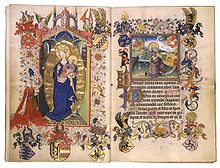
The หนังสือประจำชั่วโมง, a type of manuscript normally owned by laymen, or even more often, laywomen, became the type of manuscript most often heavily illustrated from the 14th century onwards, and also by this period, the lead in producing miniatures had passed to lay artists, also very often women. In the most important centres of illumination, ปารีส and in the คริสต์ศตวรรษที่ 15 century the cities of Flanders, there were large workshops, exporting to other parts of Europe. Other forms of art, such as small ivory reliefs, งานกระจกสี, tapestries and Nottingham alabasters (cheap carved panels for altarpieces) were produced in similar conditions, and artists and craftsmen in cities were usually covered by the guild system—the goldsmith's guild was typically among the richest in a city, and painters were members of a special สมาคมเซนต์ลูค in many places.
Secular works, often using subjects concerned with รักในราชสำนัก or knightly heroism, were produced as หนังสือวิจิตร, carved ivory mirror-cases, พรมแขวนผนัง and elaborate gold table centrepieces like เรือวิจิตร (Nef). It begins to be possible to distinguish much greater numbers of individual artists, some of whom had international reputations. Art collectors begin to appear, of manuscripts among the great nobles, like ฌองดยุคแห่งแบร์รี (1340–1416) and of prints and other works among those with moderate wealth. In the wealthier areas tiny cheap religious ภาพพิมพ์แกะไม้s brought art in an approximation of the latest style even into the homes of peasants by the late คริสต์ศตวรรษที่ 15 century.
Virgin Mary
-
The oldest Byzantine รูปสัญลักษณ์ of Mary, c. 600, จิตรกรรมสีขี้ผึ้ง, at Saint Catherine's Monastery, Mount Sinai retains much of Greek realist style.
-
Romanesque statue of the Virgin as Seat of Wisdom, คริสต์ศตวรรษที่ 12
-
The "Ravensburger Schutzmantelmadonna", painted limewood of ca ค.ศ. 1480, Virgin of Mercy type.
-
"Hunt of the Unicorn Annunciation" (ca. ค.ศ. 1500) from a Netherlandish Book of Hours collected by John Pierpoint Morgan. For the complicated ประติมานวิทยา, see Hortus Conclusus
Subsequent reputation[แก้]
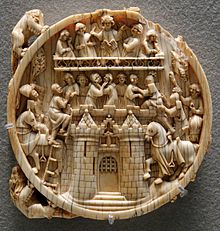
ศิลปะยุคกลางhad little sense of its own art history, and this ignorance was continued in later periods. The Renaissance generally dismissed it as a "barbarous" product of the "Dark Ages", and the term "Gothic" was invented as a deliberately pejorative one, apparently in the 1530s by Giorgio Vasari. That the Goths had ceased to feature in European history some 600 years before the style named after them appears is an indication of the vagueness as to the chronology of ศิลปะยุคกลางof the leading art historian of the day, and one relatively interested in the origins of the styles of his day. หนังสือวิจิตร continued to be collected by antiquarians, or sit unregarded in monastic or royal libraries, but paintings were mostly of interest if they had historical associations with royalty or others. The long period of mistreatment of the แท่นบูชาเวสต์มินสเตอร์ by แอบบีเวสต์มินสเตอร์ is an example; until the คริสต์ศตวรรษที่ 19 century it was only regarded as a useful piece of timber. But their large portrait of สมเด็จพระเจ้าริชาร์ดที่ 2 แห่งอังกฤษ was well looked after, like another portrait of Richard, the ฉากแท่นบูชาวิลทัน (illustrated above).
There was no equivalent for pictorial art of the "สถาปัตยกรรมฟื้นฟูกอธิคGothic survival" found in architecture, once the style had finally died off in เยอรมนี,, อังกฤษ and สแกนดิเนเวีย, and the สถาปัตยกรรมฟื้นฟูกอธิคGothic Revival long focused on Gothic Architecture rather than art. The understanding of the succession of styles was still very weak, as suggested by the title of Thomas Rickman's pioneering book on English architecture: An Attempt to discriminate the Styles of English Architecture from the Conquest to the Reformation (1817). This began to change with a vengeance by the mid-คริสต์ศตวรรษที่ 19 century, as appreciation of medieval sculpture and its painting, known as Italian or Flemish "Primitives", became fashionable under the influence of writers including จอห์น รัสคิน, เออแชน วียอเลต์-เลอ-ดุค, and ออกัสตัส พิวจิน, as well as the romantic ลัทธินิยมยุคกลาง of literary works like Sir Walter Scott's Ivanhoe (1819) and Victor Hugo's คนค่อมแห่งโนเทรอดาม (1831). Early collectors of the "Primitives", then still relatively cheap, included Prince Albert.

Among artists the German ขบวนการนาซารีน from ค.ศ. 1809 and English ศิลปะพรีราฟาเอลไลท์ from ค.ศ. 1848 both rejected the values of at least the later Renaissance, but in practice, and despite sometimes depicting medieval scenes, their work draws its influences mostly from the Early Renaissance rather than the Gothic or earlier periods - the early graphic work of จอห์น เอเวอเรทท์ มิเลส์ being something of an exception.[26] วิลเลียม มอร์ริส, also a discriminating collector of medieval art, absorbed medieval style more thoroughly into his work, as did William Burges.
By the later คริสต์ศตวรรษที่ 19 century many book-illustrators and producers of decorative art of various kinds had learned to use medieval styles successfully from the new museums like the พิพิธภัณฑ์วิคตอเรียและอัลเบิร์ต set up for this purpose. At the same time the new academic field of ประวัติศาสตร์ศิลป์, dominated by เยอรมนี, and ฝรั่งเศส, concentrated heavily on ศิลปะยุคกลางand was soon very productive in cataloguing and dating the surviving works, and analysing the development of medieval styles and ประติมานวิทยา; though the ยุคโบราณตอนปลาย and pre-Carolingian period remained a less explored "no-man's land" until the 20th century.[27]
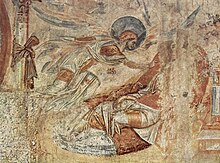
ฟรันซ์ ทีโอดอร์ คูเกลอร์ was the first to name and describe ศิลปะคาโรแล็งเชียง in ค.ศ. 1837; like many art historians of the period he sought to find and promote the national spirit of his own nation in art history, a search begun by โยฮันน์ ก็อตต์ฟรีด์ แฮร์เดอร์ in the คริสต์ศตวรรษที่ 18 century. Kugler's pupil, the great Swiss art historian ยาคอป เบิร์คฮาร์ดท์, though he could not be called a specialist in medieval art, was an important figure in developing the understanding of it. ศิลปะยุคกลางwas now heavily collected, both by museums and private collectors like จอร์จ ซาลทิง, the ตระกูลรอธไชลด์ และ จอห์น เพียร์พ็อยนท์ มอร์แกน
After the decline of the สถาปัตยกรรมฟื้นฟูกอธิค, the anti-realist and expressive elements of ศิลปะยุคกลางhave proved an inspiration for many modern artists.
German-speaking art historians continued to dominate ศิลปะยุคกลางhistory, despite figures like Émile Mâle (1862–1954) and อองรี โฟซิลยอง (1881–1943), until the Nazi period, when a large number of important figures emigrated, mostly to Britain or America, where the academic study of art history was still developing. These included the elderly อดอล์ฟ โกลด์ชมิดท์ and younger figures including นิโคลัส เพฟเนอร์, เอิร์นสท์ คิตซิงเกอร์, เออร์วิน พานอฟสคี, เคิร์ต ไวทซมันน์, ริชาร์ด เคราท์ไฮเมอร์ and many others. ไมเยอร์ ชาปีโร had immigrated as a child in ค.ศ. 1907.
- ↑ Fordham University Josiah Russell's figures - all estimates are of course very imprecise. See Consequences of the Black Death for more details.
- ↑ The White Tower was started in ค.ศ. 1078, and some later royal apartments in the Tower of London survive, as do the hall and parts of Eltham Palace, the most significant medieval remains from an unfortified royal palace. Royal apartments survive in some castles.
- ↑ the small Carolingian(?) Equestrian Statue of an Emperor in the Carnavalet Museum in Paris, Hinks, 125-7; and the คริสต์ศตวรรษที่ 12(?)-century bronze of a man wrestling with a lion, variously considered English, German or Sicilian in origin, discussed by Henderson 1977, pp. 135–139.
- ↑ Grocock, Chris has some calculations in Mayo of the Saxons and Anglican Jarrow, Evidence for a Monastic Economy, according to which sheep required only one third as much land per page as calves. 1,600 calves seems to be the standard estimate, see John, Eric (1996), Reassessing Anglo-Saxon England, Manchester: Manchester University Press, p. 14, ISBN 0719050537
- ↑ Campbell 1998, p. 29 – the following pages describe gold, pigments and other materials.
- ↑ Dates are discussed in Calkins 1979, pp. xix–xx, Kitzinger 1955, p. 1, Beckwith 1964, p. 9.
- ↑ Henderson 1977, p. 18.
- ↑ Kitzinger, pp. 57–60.
- ↑ According to Bede, our only documentary source.
- ↑ Henderson 1977, ch. 2; Calkins 1979, chs 8 & 9; Wilson 1984, pp. 16–27 on early Anglo-Saxon art.
- ↑ Dodwell 1993, pp. 74(quote)–75, and see index.
- ↑ Honour 1982, pp. 256–262.
- ↑ Honour 1982, p. 269.
- ↑ Beckwith 1964, pp. 206–209.
- ↑ Hinks 1974, Parts II & III; Kitzinger 1955, ch. 2; Calkins 1979, chs 11 & 12.
- ↑ Kitzinger 1955, pp. 75–77.
- ↑ Dodwell, 56 & Beckwith, 39-43.
- ↑ Beckwith 1964, pp. 145–149.
- ↑ Henderson 1977, pp. 190(quote)–195.
- ↑ Honour 1982, pp. 277 & 284-288. Beckwith 1964, p. 149, says the bronze column at Hildesheim of ราว ค.ศ. 1020 "cannot be said to be Romanesque … It stands apart as a curious Ottonian pastiche of a Roman monument … never to be repeated"
- ↑ Bernard's letter
- ↑ Dodwell 1993, pp. 212–214. The MS is the Dijon Moralia in Job of Gregory the Great.
- ↑ Honour 1982, p. 271.
- ↑ The Historical Museum of Bern has many of the best pieces, and these and others were shown in an exhibition on Philip in Bern, Bruges and Vienna in 2008-9.
- ↑ Plummer 1964, plates 1–2.
- ↑ In works like this, stylistically very different from the finished painting.
- ↑ Kitzinger 1955, pp. 1(quote)–2.












![Another Carolingian evangelist portrait in Greek/Byzantine realist style, probably by a Greek artist, also late 8th century.[17]](http://upload.wikimedia.org/wikipedia/commons/thumb/d/d3/Coronation_Gospels_-_St_John.png/96px-Coronation_Gospels_-_St_John.png)









